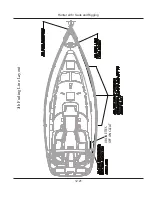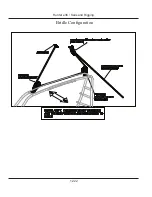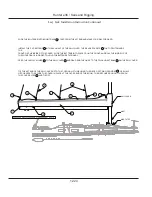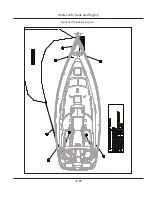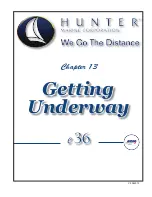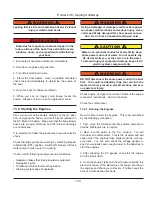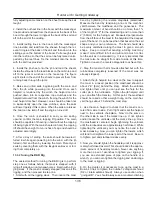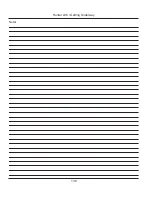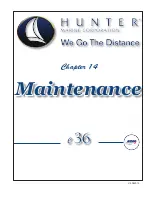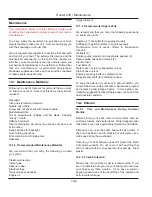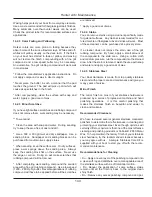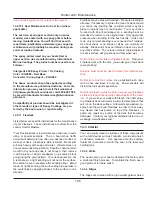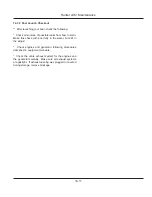
Hunter e36 • Getting Underway
13.5
fully adjusting some tension on the sheet to keep the sail
taught.
2. Install the out haul line in the boom with the messenger
line provided and lead from the sheave at the back of the
boom through the lower cringle at the back of the sail and
aft to the end of the casting.
3. Install reefing lines in the boom with the messenger
line provided and lead from the sheave through the rel-
evant cringle at the back of the sail and then down to the
sliding eye on the bottom of the boom. Pull enough slack
into the reef line so that the sail can be fully raised unim-
peded by the reef lines. Tie the mainsail onto the boom
with the sail ties provided.
4. Install the jib sheet onto the jib and lead the sheets
inside the shrouds to the lead blocks on the cabin top and
aft to the jams or winches on the house top. Tie figure
eight knots in the end of the sheets to prevent them from
running back through the jams.
5. Raise and unfurl sails, beginning with the main and
then the jib while powering into the wind. Once each
halyard, is tensioned by the winch, the halyard can be
pushed down into its respective rope clutches and the
halyard removed from the winch, freeing the winch for the
next halyard or sheet. However, care should be taken not
to inadvertently open the rope clutches, since the sails
will lower rapidly if this is done. When the sails are raised,
the boat can be laid off and the engine turned off.
6. Once the main is sheeted in and you are sailing
upwind, confirm the main topping lift position. The main
should be capable of sheeting in hard without the topping
lift being tight. With the main sheeted in hard, the topping
lift should have eight to ten inches of sag and should be
adjusted accordingly.
7. After a day of sailing, the sails should be lowered /
furled in while again powering into the wind, with the jib
furled in first and then by lowering the main. Protect your
sails by covering them with the lazyjack sailcover or furl-
ing them completely up.
13.3.2 Tuning the B&R Rig
The easiest method for tuning the B&R rig is to perform
step one as follows before the mast is stepped, with it
lying aft side down on two sawhorses. Begin with all rig-
ging slack. If the mast is already stepped, loosen all the
rigging, and then proceed to step one.
1. Start with all the rigging slack. Then induce the mast
bend by tightening the reverse diagonals (diamonds).
Measure the band by tensioning a line or the main hal-
yard between the masthead and the gooseneck. The
maximum amount of bend should be no more than 1%
of the length of “P” for the standard rig and no more than
2” (50mm) for the furling mast. Measured perpendicular
from the aft face of the mast to the halyard at the deepest
part of the bend. It can be less than that based on the sail
shape and your own preference. The bend should also
be evenly distributed along the mast to give a smooth
shape. Keep in mind that bending a furling mast may
make it more difficult to furl and will not do much to flat-
ten the sail as in a standard rig. It is very important that
the mast also be straight from side to side at this time.
Tighten or loosen the reverse diagonals to achieve this.
2. Step the mast with all shrouds attached but with the
turnbuckles completely loosened (if the mast was not
already stepped).
3. Attach the jib halyard to a cleat on the bow to support
the mast in a raked position (the masthead should be
about 2’-0” {6cm} behind the step). Attach the verticals
and tighten them until you can just see the hole for the
cotter pin in the turnbuckle. Tighten the jib halyard until
you can attach the forestay. At this point, the masthead
should be raked so that a weight hung on the main hal-
yard hangs about 1’ behind the mast step.
4. Use the main halyard to check that the mast is cen-
tered from side to side. Pull it tight and mark the halyard
next to the verticals chainplate. Now do the same in
the other side to see if the marks line up. If not, tighten
and/or loosen the verticals until the marks line up. Once
the masthead is centered, begin tightening the verticals
until the turnbuckles are approximately half closed. While
tightening the verticals, you may notice the bend in the
mast increasing. Now you can tighten the lowers, which
will tend to straighten the lower part of the mast. Be sure
to tighten port and starboard sides evenly.
5. Now you should tighten the headstay until it is approxi-
mately half closed as well. This should induce the approx-
imate amount of headstay tension. Never use anything
more than a pair of wrenches to tighten your rigging. If
you use an extended piece of pipe on the handle of a
wrench, you can over-tighten the rigging and do damage
to the mast or rigging.
6. On the Hunter, it is necessary to go up the mast in a
Bosun’s Chair to tighten the number 2 diagonal shroud
(D2 or intermediate shroud). Always use caution when
“going aloft”. You should always use a mountain climbing
Summary of Contents for e36
Page 1: ...V2 062012 Operator s Manual e 36 ...
Page 2: ......
Page 9: ...V2 062012 Introduction e 36 Chapter 1 ...
Page 14: ...Hunter e36 Introduction 1 6 Notes ...
Page 15: ...Documents Forms e 36 Chapter 2 and V2 062012 ...
Page 26: ...Hunter e36 Documents and Forms Maintenance Log Date Maintenance Performed Hourmeter 2 12 ...
Page 27: ...Hunter e36 Documents and Forms 2 13 Date Maintenance Performed Hourmeter Maintenance Log ...
Page 33: ...Hunter e36 Documents and Forms 2 19 Spare Parts List ...
Page 34: ...Hunter e36 Documents and Forms Dates of practice drills and onboard safety inspections 2 20 ...
Page 35: ...Hunter e36 Documents and Forms 2 21 My personal preferences for maintenance items safety gear ...
Page 36: ...Hunter e36 Documents and Forms Notes 2 22 ...
Page 37: ...V2 062012 Limited Warranty e 36 Chapter 3 ...
Page 38: ...This Page Intentionally Left Blank Hunter Limited Warranty 3 2 ...
Page 47: ...Boating Safety e 36 Chapter 4 V2 062012 ...
Page 65: ...Deck Hardware Hunter e36 Boating Safety 4 19 ...
Page 67: ...Hunter e36 Boating Safety 4 21 Notes ...
Page 68: ...Hunter e36 Boating Safety 4 22 Notes ...
Page 69: ...V2 062012 Fuel Systems e 36 Chapter 5 ...
Page 75: ...Fig 5 7 A Quick Fuel Filter Reference Hunter e36 Fuel Systems 5 7 ...
Page 82: ...Notes Hunter e36 Fuel Systems 5 14 ...
Page 83: ...V2 062012 Underwater Gear e 36 Chapter 6 ...
Page 92: ...Hunter e36 Underwater Gear 6 10 Notes ...
Page 93: ...V2 062012 DC Electric Systems e 36 Chapter 7 ...
Page 103: ...Hunter e36 DC Electric 7 11 7 8 BASIC DC POWER SUPPLY SYSTEM DIAGRAM ...
Page 104: ...Hunter e36 DC Electric 7 12 Notes ...
Page 106: ...Hunter e36 DC Electric 7 14 Notes ...
Page 107: ...V2 062012 AC Electric Systems e 36 Chapter 8 ...
Page 115: ...Hunter e36 AC Electric Systems 8 9 7 8 AC DC Electric Power Supply Diagram ...
Page 116: ...Hunter e36 AC Electric Systems 8 10 This Page Intentionally Left Blank ...
Page 117: ...Hunter e36 AC Electric Systems 8 11 Notes ...
Page 118: ...Hunter e36 AC Electric Systems 8 12 Notes ...
Page 119: ...V2 062012 Water Systems e 36 Chapter 9 ...
Page 126: ...Hunter e36 Water Systems 9 8 This Page Intentionally Left Blank ...
Page 128: ...Hunter e36 Water Systems 9 10 This Page Intentionally Left Blank ...
Page 129: ...Hunter e36 Water Systems 9 11 Notes ...
Page 130: ...Hunter e36 Water Systems 9 12 Notes ...
Page 131: ...V2 062012 Waste Systems e 36 Chapter 10 ...
Page 137: ...Hunter e36 Waste and Sanitation Systems 10 7 ...
Page 140: ...This Page Intentionally Left Blank Hunter e36 Waste and Sanitation Systems 10 10 ...
Page 141: ...Sump Pump Layout Grey Water Hunter e36 Waste and Sanitation Systems 10 11 ...
Page 142: ...This Page Intentionally Left Blank Hunter e36 Waste and Sanitation Systems 10 12 ...
Page 144: ...Hunter e36 Waste and Sanitation Systems 10 14 Notes ...
Page 145: ...V2 062012 Engines Transmissions e 36 Chapter 11 and ...
Page 154: ...Hunter e36 Engines and Transmissions 11 10 This Page Intentional Left Blank ...
Page 155: ...V2 062012 Sails Rigging e 36 Chapter 12 and ...
Page 162: ...Hunter e36 Sails and Rigging 12 8 Standing Rigging Details Standard ...
Page 163: ...Hunter e36 Sails and Rigging 12 9 Standing Rigging Details Furling ...
Page 164: ...Hunter e36 Sails and Rigging 12 10 Mast Upper Spreader Tip Details H A B C D E F G ...
Page 165: ...Hunter e36 Sails and Rigging 12 11 C A B D E F G H J K I Mast Lower Spreader Tip Details ...
Page 166: ...Hunter e36 Sails and Rigging 12 12 Standing Rigging Details ...
Page 170: ...Hunter e36 Sails and Rigging 12 16 Typical Boom Reefing Layout ...
Page 171: ...Hunter e36 Sails and Rigging 12 17 Rope Vang Details Standard Vang Details ...
Page 172: ...Hunter e36 Sails and Rigging 12 18 Rigid Vang Details Optional Vang Details ...
Page 175: ...Hunter e36 Sails and Rigging 12 21 JIB LINE TIES OFF ON CLEAT Jib Furling Line Layout ...
Page 176: ...Hunter e36 Sails and Rigging 12 22 Bridle Configuration ...
Page 179: ...Hunter e36 Sails and Rigging 12 25 Optional Spinnaker Layout ...
Page 180: ...Hunter e36 Sails and Rigging 12 26 Notes ...
Page 181: ...V2 062012 Getting Underway e 36 Chapter 13 ...
Page 188: ...Hunter e36 Getting Underway 13 8 Notes ...
Page 189: ...V2 062012 Maintenance e 36 Chapter 14 ...
Page 202: ...Notes Hunter e36 Maintenance 14 14 ...
Page 203: ...Exterior Lifting Points Hunter e36 Maintenance 14 15 ...
Page 204: ...Hunter e36 Maintenance 14 16 This Page Intentionally Left Blank ...





